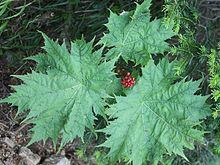Rank Species | ||
 | ||
Similar Oplopanax, Rubus vernus, Parasenecio adenostyloides, Tiarella polyphylla, Aletris foliata | ||
Oplopanax japonicus (Nakai) is deciduous shrub that can grow as high as 3 m (9.8 ft) tall. The plant is densely packed with spikes and those spikes are irritant. This species of plant belongs to a genus that is rich in calcium oxalate, which is toxic to the digestive system.
Contents
Distribution
Oplopanax japonicus is naturally found in East Asia, specifically in Japan. It is usually found in the coniferous shady forest of Northern Japan. One species is also found in China and North America.
Habitat and Ecology
Oplopanax japonicus grow in woodland garden and dappled shade, shady edge and not in deep shade.The optimal cultivation environment is a moist, well drained and retentive soil.
Morphology
O. japonicus is a hardy frost resistant shrub. It is also the most spiny member of the ginseng family. It forms seldom and randomly branched stems that are approximately 1 m long. Deciduous, can grow up to 3 m (9.8 ft) tall, Branches bulky, with solid yellow-orange prickles. The stem is prickly and stocky. Petiole 3–10 cm (1.2–3.9 in), densely covered with setae. The leaf blade approximately circular to oblate, the leaf is approximately 15–30 cm (5.9–11.8 in) wide, the two surfaces are usually 5–7 lobed. The shape of the lobe is triangular or broadly triangular, base cordate, margin irregularly serrate, apex acute to slightly acuminate. They have ornamental qualities but are armed with spikes. The plant also features spiny leaves and stems.
Flowers and fruit
Flowers of Oplopanax japonicus, is usually hermaphrodite (having both male and female organs). Inflorescence terminal, a raceme of umbels, length of 8–25 cm (3.1–9.8 in), densely covered with setae towards the bae, stiffly covered with tiny hairs throughout; umbels length of 0.9–1.3 cm (0.35–0.51 in) in diameter. Usually 6–12 flower with proximal peduncles that is 2.5 cm (0.98 in) long. Calyx 5-toothed and glabrous. Styles united to middle, slender and apical. Fruit yellow-red at maturity, and sometimes globose.
Food
The leaves and roots of Oplopanax japonicas can be used as food. Young shoots have to be thoroughly peeled and cooked for eating. Roots can be cooked or chewed.
Herbal medicine
Oplopanax japnicus is used in herbal medicine. The root bark and stem are analgesic, antiphlogistic, antirheumatic, hypoglycaemic and tonic. Oplopanax japonicus was once used in Japan for treating diabetes. Although no cure was recorded by this treatment, it did relieved some patients from their reliance on insulin injection.
From the inner bark of the plant, extracts have been isolated and have shown antibacterial, antiviral, and antifungal activity. The active ingredient has been attributed to several polyynes. In addition, one sesquiterpene has also been isolated and the derivative of the ketone form has been commercially produced in Japan to treat cough. An example of the sesquiterpene that has been isolated and characterized is oplapanone.
